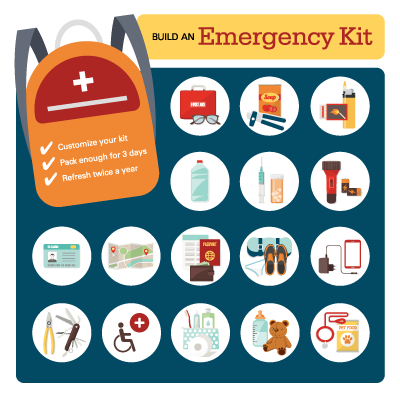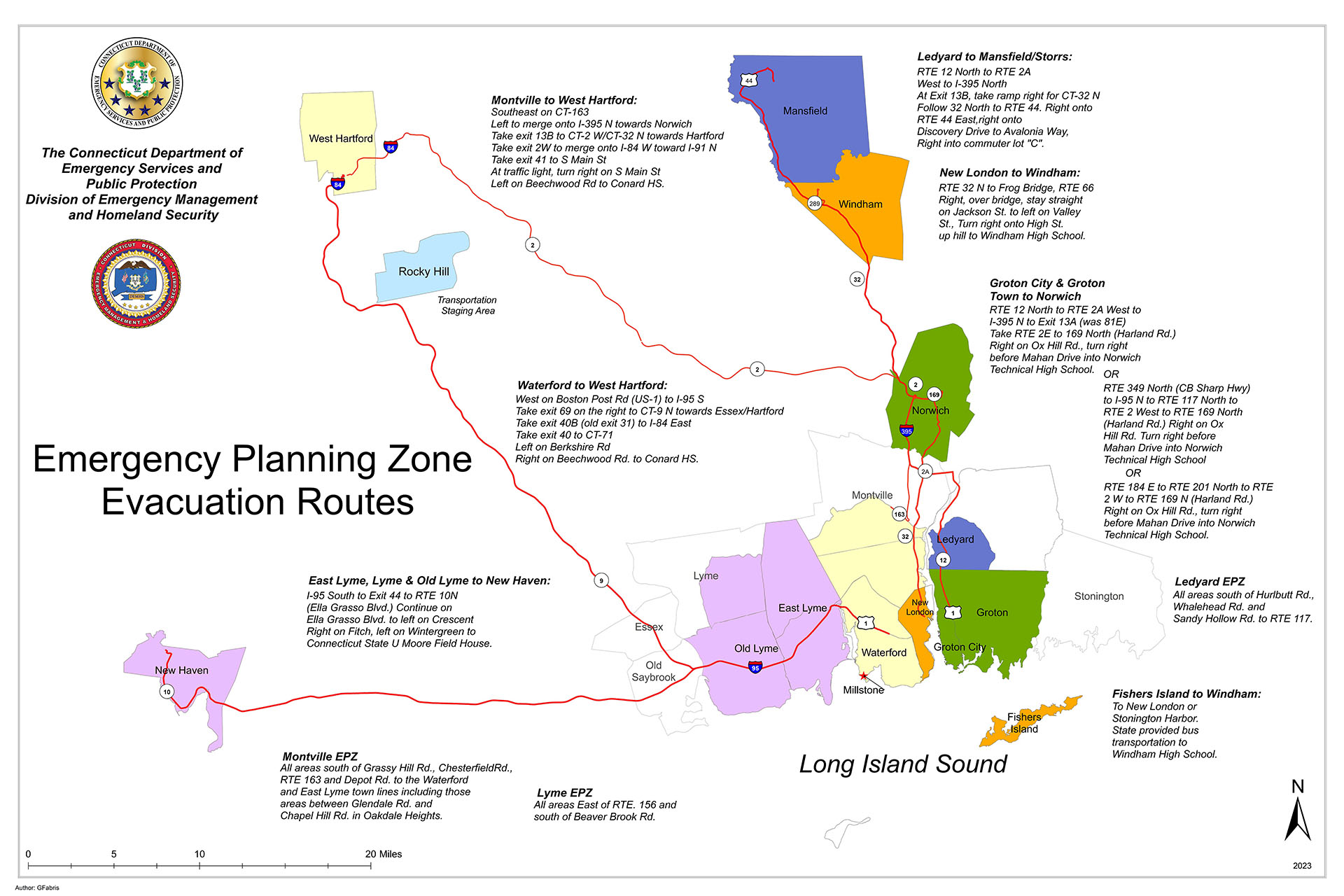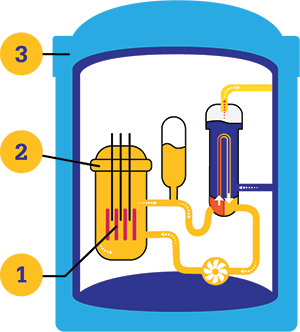How can we help you?


It is important to know which types of disasters could affect your area. Your Emergency Plan will contain emergency contacts, medical information, your emergency planning zone (EPZ), evacuation and sheltering information, and more.
Your Emergency Kit should have supplies to last at least three days for each family member. Keep it in an easy-to-carry bag, such as a backpack, duffel bag, or suitcase.
Kit items to include:
Persons with critical needs who may need help in an evacuation - Complete and return the Functional Needs and Assistance Survey Card. This survey card is mailed to you every year.
Residents must complete and mail, at no cost, the survey card every year. Only include information that will prevent you from self-evacuating your home. Survey information is given to your city or town's emergency management official to ensure information is up-to-date and, if needed, provide assistance in an emergency or evacuation. You may also contact your locality to learn what options are available. Locality and state contact information is provided under More Information below.

Not all shelters and hotels accept pets. Plan ahead to stay with family, friends, or at pet-friendly locations if you need to evacuate your home. If a hotel has a no-pets policy, ask the hotel if they can waive the policy during the emergency. Don’t hesitate to leave your home in an emergency because you don’t want to leave your pet(s) behind.
Kit items to include:

Local Emergency Alert System (EAS) radio and TV stations will have information and provide actions to take to keep you safe in the unlikely emergency event at Millstone Power Station. The public will also be alerted and notified of an emergency via sirens, EAS broadcast on local radio and television, and CT Alert (if subscribed).
In an emergency, sirens will be activated to a steady tone for three minutes (that may be repeated). These sirens are maintained and routinely tested throughout the year by Millstone Power Station. When you hear the siren, tune in to local radio and/or TV station for emergency information and instructions.
Hearing sirens is NOT an immediate signal to evacuate. It means tune in to local radio or television station and listen for information and instructions on what to do.
CT Alert is the State of Connecticut’s emergency notification system to alert residents anywhere in the state about life-threatening emergency conditions. By signing up for CT Alerts and keeping your contact information up-to-date, you will receive alerts and other essential information quickly in an emergency.
In an emergency parents of school children need to listen to local TV and/or radio stations for updates on school status and instructions. Emergency officials will advise schools on what actions to take.
| Radio | TV Station | ||
| Norwich | Hartford | Norwich/Hartford | |
| WCTY 97.7 FM WNLC 98.7 FM WWRX 107.7 FM WNPR 89.1 FM WKNL 100.9 FM WQGN 105.5 FM WPKT 90.5 FM WMOS 102.3 FM WBMW 106.5 FM |
WMRD 1150 AM WXLM 980 AM WLIS 1420 AM WICH 1310 AM |
WTIC 1080 AM WDRC 1360 AM WTIC 96.5 FM WDRC 102.9 FM |
WFSB Ch. 3 WTNH Ch. 8 WHPX Ch. 26 WVIT Ch. 30 WTIC Ch. 61 |
United States Coast Guard (USCG): Will broadcast waterway advisories for the emergency planning zone via very high frequency (VHF) marine radio. For waterway questions, contact USCG Sector Long Island at 203-468-4401 or via VHF radio channel 16.
Connecticut Network (CT-N): In an emergency, CT-N will provide emergency information directly from the State Emergency Operations Center.
CT 2-1-1: In an emergency, CT 2-1-1 will serve as the state information hotline. Dial 2-1-1 from anywhere in Connecticut 24 hours a day. Multilingual specialists are also available. If you are outside of Connecticut or have a problem using the 2-1-1-number or dial 800-203-1234.
Communities located within the 10-mile area of Millstone Power Station are included in the 10-mile emergency planning zone (EPZ). Following a General Emergency, people in parts of the 10-mile EPZ may be directed to take protective actions such as sheltering-in-place, evacuation, take potassium iodide (KI) if recommended, or monitor and prepare.
Below are the 10 communities within the 10-mile area of Millstone Power Station:

Listen carefully to instructions specific to your area. If told to evacuate, you may be instructed to report to a Host Community Reception Center (or simply known as Reception Center). Each community is designated to evacuate to a Reception Center in one of five Host Communities (New Haven, West Hartford, Mansfield/UCONN/Storrs, Willimantic/Windham and Norwich). Officials may have important information about evacuation routes or may re-direct your town to an alternative Host Community.
Reception Centers offer contamination monitoring and, if needed, assist in decontamination of people, pets, and vehicles. Other services include reuniting family members, crisis counseling, basic emergency medical services, potassium iodide (KI) tablets if you have not yet obtained your KI, and American Red Cross services (e.g., connection to shelters).
Unless told otherwise, use the primary evacuation route below to get to your assigned Reception Center, or view the evacuation route information in the Millstone Power Station EPZ Evacuation Zones Map.
If an evacuation is ordered, listen closely to emergency officials to see if your area of town should evacuate and for instructions about reporting to an evacuation reception center. Each community is designated to evacuate to a reception center in one of five Host Communities (New Haven, West Hartford, Mansfield/UCONN/Storrs, Willimantic/Windham and Norwich). Officials may have important information about evacuation routes or may re-direct your town to an alternative Host Community.
Identify your assigned Reception Center and primary evacuation route from the list below.
If Your Community (Emergency Planning Zone) is Told to Evacuate:
If you must go outside, cover your mouth and nose with a cloth (e.g., folded handkerchief or towel) to help prevent breathing in radioactive particles. Move quickly and limit outdoor time to as little as possible. Remove the outer layer of your clothing when you return inside and place in a plastic bag. Wash all exposed body parts with lots of soap and lukewarm water to remove potentially radioactive particles from your body. These steps will help reduce exposure to harmful radioactive material. For more tips and guidance on self-decontamination, visit CDC’s How to Self-Decontaminate after a Radiation Emergency.
Not every radiological emergency will result in the release of radioactive material. Potassium iodide (or KI), non-radioactive form of iodine, may be recommended as an additional protective measure to help protect your thyroid gland in the event of a radiological emergency.
Those living and/or working within the 10-mile area of Millstone Power Station can get their KI at the locations listed below (EXCEPT during emergencies). No appointment necessary. Hours of operation can be found on the location’s website or calling the contact number. During an emergency, KI will be available at your designated Reception Center.
If KI is recommended, it is important to follow exact amount directed for your age group. Especially in young children and infants, giving too much KI can cause more harmful effects and health issues. Go to Connecticut’s Potassium Iodide Fact Sheet to see how much KI you should take for your age group. Visit Connecticut's Potassium Iodide (KI) Program webpage for more information on KI.
| Town / City | Location and Contact Number |
|---|---|
| East Lyme | Town Hall 108 Pennsylvania Ave. 860-739-6931 (Ext.1135) |
| Fishers Island | Fishers Island Fire Dept. 250 Athol Crescent Ave. 631-765-2600 |
| Groton City | Groton Municipal Building City Clerk’s Office 295 Meridian St. 860-446-4102 |
| Groton Town | Town Hall Groton Town PD |
| Ledyard | Ledyard Regional VNA Ledyard Police Dept. |
| Lyme | Town Hall Town Clerk’s Office 480 Hamburg Road (Route 156) 860-434-7733 |
| Montville | Town Hall Office of the Fire Marshal and Emergency Management 310 Norwich - New London Tpke. 860-848-1417 |
| New London | Fire Headquarters North Station Fire Dept. South Station Fire Dept. |
| Old Lyme | Town Hall 52 Lyme Street |
| Waterford | Waterford Police Dept. Town Hall |
Livestock and poultry owners are responsible for the care and wellbeing of their animals. Livestock and poultry owners, farmers, and producers should develop and maintain an emergency plan specific to their needs to use in the case of an evacuation.
Nuclear plant emergencies may impact livestock, food, and agricultural products. Protective actions for livestock and agricultural products will be issued by appropriate state and local officials. These actions may include:
If you have livestock or agricultural products, download the Radiological Emergency Information for Connecticut’s Agricultural Community brochure, or call 1-800-397-8876 to request a copy. You may also visit the Connecticut Animal Response Team website that contains a wealth of resources for preparing and responding to animal needs in disasters.
Download the U.S Department of Agriculture’s (USDA) Livestock Preparedness Fact Sheet for additional guidance on protecting livestock in emergencies.
If an accident were to occur at Millstone Power Station, the area within 50 miles of the station would be assessed to determine if there has been any impact on the environment. If there has been any impact, the public in the affected area would be notified. If any actions are necessary, the public would be informed of the actions to be taken. The Connecticut Radiological Emergency Plan (CT-REP) has procedures in place for emergencies that extend beyond 10 miles from Millstone Power Station. This includes assessing food and drinking water for contamination and determining the need for additional public protective actions.
Nuclear power plants are designed, engineered, and operated to adhere to stringent safety and security regulations and practices. Multiple layers of safety systems and structures protect the plant and community from an emergency:
There are three fission product barriers (also referred to as protective barriers) that prevent the release of radioactive material into the environment: (1) fuel cladding, (2) reactor vessel and cooling system, and (3) containment.
The Nuclear Regulatory Commission (NRC) defines four emergency classifications that could occur at a nuclear power station. Dominion Energy would contact federal, state, and local authorities in each of the following situations:

Visit or contact your local/state emergency management or public safety agency for additional emergency preparedness and response information specific to your area.
Download the CTPrepares Mobile App the official mobile app of CT DESPP. You can build your own emergency plan(s), emergency kit, stay connected to friends and family, and receive emergency information and alerts. The app contains other functionality to keep you prepared and informed, including the ability to function without the need of a data connection. Download free today at Apple App Store.